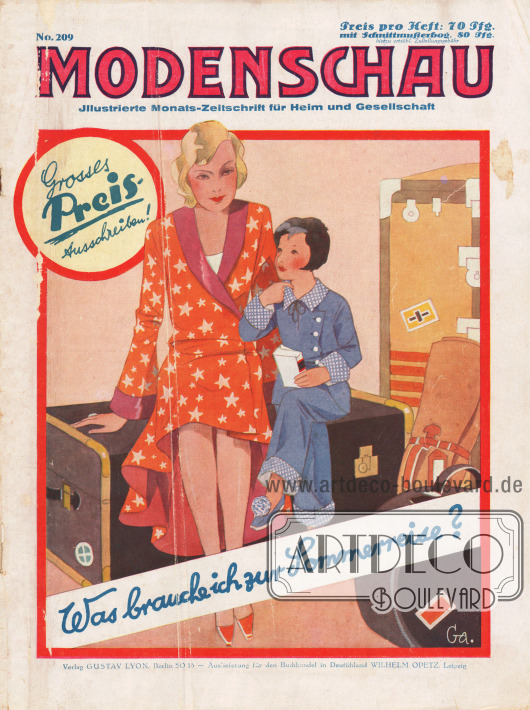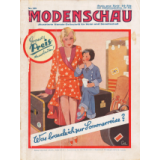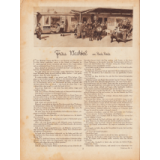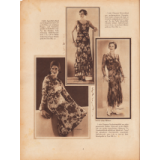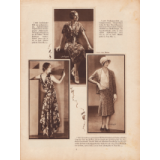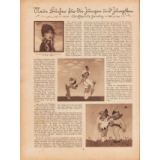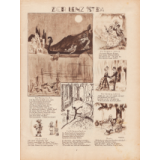|
|
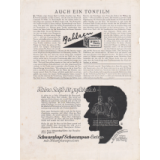
|
Article:
N. N., Also a Talkie;
Paula, Anna, Dear Friend! I Advise You… (by Anna Paula, unknown author).
Advertising:
Bahlsen Leibniz Cookie. Contains only the finest dairy butter.
Pure soap is dangerous – yes, even too much soap in your shampoo can harm your hair. This is due to certain after-effects of the alkalis contained in any soap, which, on the other hand, are necessary to dissolve grease and dirt. In all Schwarzkopf hair care products, the cosmetic additives ensure that the alkaline effect is such that your hair is cleaned, but all the disadvantages are eliminated.
Despite good rinsing, however, it is impossible to avoid alkaline residues remaining in the hair during any head wash. They are bound by Schwarzkopf Hair Shine Powder. This hair astringent "neutralizes" your hair, restores its strength and gives it an extra shine.
So if you want to keep your hair healthy and beautiful in the long run, use Schwarzkopf-Haarglanz-Pulver [Hair Shine Powder] after every head wash.
Every bag of Schwarzkopf Extra comes with Haarglanz-Pulver free of charge.
Schwarzkopf-Schaumpon-Extra [Shampoo] with Hair Shine Powder.
Too much salt spoils the food. Too much alkali damages the hair. It depends on the right measure!
Free coupon for Schwarzkopf-Haarglanz-Pulver!
Send with address to Hans Schwarzkopf, Berlin-Tempelhof 36. Drawing/illustration: "(BA)" (unknown signature).
|
|
P. 3 |
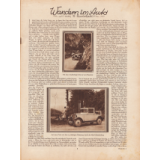
|
Article:
Rudolphi, Rose, Hiking in a Car (by Rose Rudolphi, unknown author).
The article is supplemented by two photographs with the captions ""With the 8-cylinder Stoewer at the Frauensee" and "On a trip with the 4-cylinder Hanomag through the Mark Brandenburg."
Photos: unsigned/unknown.
[Rudolphi, Rose, Hiking in a Car.]
Long behind us are the years when the car was a luxury item and only within reach of very wealthy circles. The automobile industry has changed and today delivers beautiful and usable cars of which quite a few types are hardly more expensive than a piano. But while in the past a piano was not always considered a useful piece of furniture by neighbors and family members, the owner of a car is always considered a clever man … perhaps because it is easier for everyone to learn to drive a car smoothly and safely than to play the piano correctly. Even against the lady in a flounce dress at the steering wheel, who has to put up with the inapplicable designation "gentleman driver," every prejudice has disappeared, and more and more often one sees how women steer their car through the densest bustle of the big city streets, yes, how they carry their head more securely in precarious situations than men, who very easily get nervous at the steering wheel. That's why a car today is a family affair that doesn't necessarily belong to the man's portfolio. Which car to choose is a question that can best be answered in this way: one that combines all the advantages. It is a mistake to think that only an expensive car can do this! In photography today, we see that expensive hand-made cameras are being replaced by factory-made cameras, which, despite their low price, are equipped with good optics. It is quite similar with cars, which can be supplied cheaply by the manufacturer as a result of series production, without losing the slightest quality, and whose spare parts are not only cheap but also available everywhere due to standardization. The flat tire, so feared by many non-drivers, has become obsolete today, because the system of spare wheels allows even a lady to change on the highway without male help, with the aid of a wrench and winch, the operation of which requires little force. Other repairs, which may also occur, are so simplified that no technical study is required to perform them. In this respect, the Hanomag's car design is exemplary, and it is also very popular with ladies because of its elegant construction. A drive in the mountains, over serpentines, which already begin in the Harz Mountains, becomes enjoyable when the "Stoewer 8," thanks to its excellent construction, runs almost by itself and does not rob the eye of the delightful distant view. — Even if the car has already become a necessity in small towns or in the suburbs of a large city, its full appeal only unfolds when it serves us to escape the confines of the city into nature. The greatest advantage, which cannot be appreciated enough, is that having one's own car makes one completely independent of all the ties that otherwise have to be taken along on a trip. Youth, which likes to turn against every constraint, easily hangs its satchel over its back and tries to reach its destination on wanderlusting feet. But on the one hand, youth is unfortunately a very temporary condition, and on the other hand, the radius that a wanderer can cover with limited time is quite small. Who, by the way, still has time for long extended hikes, as far as he does not use his vacations for it, and who would not have been glad as a pedestrian sometimes, if he had been able to escape from a boring area!
For the best feature of the car, to make the owner independent of public transport, everyone learns already at the first exit. The railroad timetable cannot take into account special requests, but it is precisely because of it that many hours of precious time are lost unused. Who has not cursed the agonizing wait at dreary stations on branch lines, where slow trains crawl through the country at a snail's pace. The charming places, however, always have the characteristic of being off the road of general traffic. To quite a few of them there is no connection at all other than an hour-long walk from a small train station. A car helps here to overcome all doubts. There is no need to worry beforehand whether one will reach the train, which usually leaves at an inconvenient hour and thus already interferes with dear habits; disturbed morning sleep, hasty breakfast, all sorts of small annoyances mark the beginning of many an excursion, the success of which depends on rail connections. The own car, however, has the even greater advantage that it can be set in motion and stopped as often as one wants. How many times has it happened to one on a railroad trip that the train passed a beautiful mountain scenery, a charming forest meadow, a rushing brook, and the wish came alive that one could rest here for an hour. Of course, the railroad is not equipped for such wishes, it cannot be at all, and for technical reasons the railroad usually forces its passengers to get off at completely charmless places. How different the car! No sooner does the desire to linger in a place so beautiful come to life than all it takes is a stop the automobile and the wish is fulfilled. How much more pleasant is a picnic at the edge of the forest than a feeding in the always overcrowded dining car, at whose windows the landscape flies by at breakneck speed! Or it can, … (end on page 13).
[Page] 3
|
|
P. 8 |
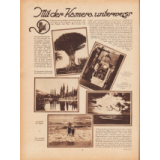
|
Article:
N. N., On the Road with the Camera.
The article is illustrated with five photographs with the captions "A three-thousand-year-old dragon tree on Tenerife," "Interior of St Mark's Basilica in Venice," "Landscape near Ragusa," "Shot of an impressive cloud formation over the Baltic Sea," and "Two cute Baltic Sea crabs."
Photos: unknown/unsigned.
[N. N., On the Road with the Camera.]
The conquest of the landscape through the impression that the eye receives from it is certainly the most important task of a journey. But in the midst of the diversity of images, which is inevitable on a long journey, it very often happens that the memory fades and the individual impressions no longer have the necessary sharpness to form themselves into the necessary sculpture. Yes, if only we had a mechanical reproduction that could immediately refresh the half or completely forgotten impressions! How often has this call been made when travel experiences were to be refreshed years later by means of picture postcards. Picture postcards are now suitable in many cases to support the memory, but they lack the personal touch. Everyone sees a landscape, a famous building or a street differently – and it is precisely this very individual angle that creates the unique experience that no one else can recreate. The only thing that can help here is the camera, which can be adjusted to suit the viewer and which can always tell more than words can, indeed, which can capture the finest details that do not always present themselves to the eye with the necessary clarity. Photography is so easy today that no one should shy away from the small effort of adding a camera to the most necessary equipment for their travels.
Gone are the tedious preparations, forgotten are the numerous auxiliary devices that used to be part of a successful shot. Today, we no longer want posed "pretty" pictures, but snapshots that arise from the right mood and that capture every impression as truthfully as we feel it at that moment. What each individual snaps, and how he personally relates to the subjects, whether he likes overall shots or just details in front of the camera, whether he lets the landscapes themselves or just people… [End on page 45].
[Page] 8
|



